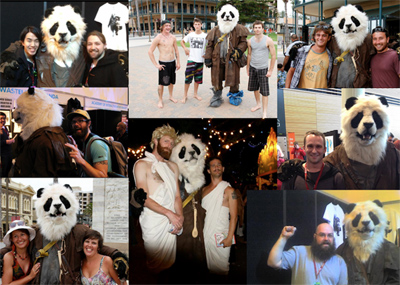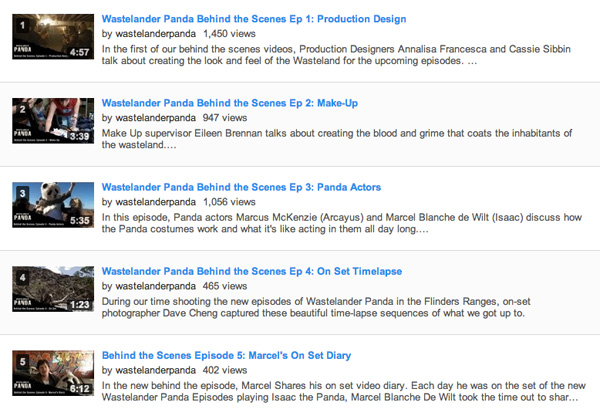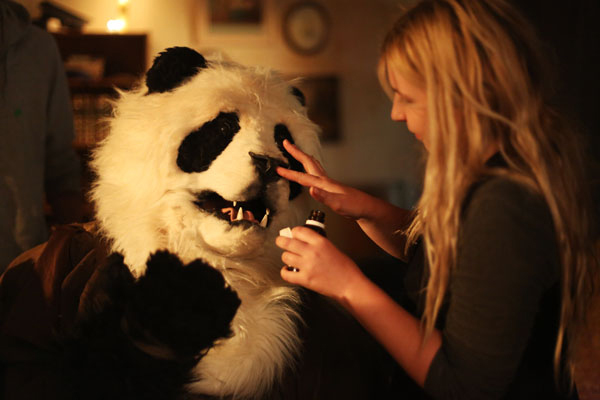by Kirsty Stark (Producer), Ella Macintyre (PMD) and Victoria Cocks (Writer/Director)
Part 4. Production: Keeping our Audience Engaged
Once we had our project funded, we needed to find a way to keep our audience engaged over the year it took to write, produce and release our three Wastelander Panda films.
When we released our Prologue, it was nothing more than a three-minute film, so all of the traffic we gained was directed back to our production company, Epic Films, via our website and Facebook page. This was far from ideal, especially considering that the company’s two other short films, L’Artiste! and Landscape Scene, were very different in tone and subject matter. We needed to separate our Wastelander Panda branding in order to give it the best possible chance of succeeding online long-term, so our first step after funding the project was to create a new Wastelander Panda website (at this stage a WordPress blog), Facebook page and Twitter account.

It turned out to be much more difficult than anticipated to migrate all of our fans over to the new pages. This taught us a great lesson about how hard it is to engage people on a day-to-day basis. It was around six months after launching the new Facebook page that it finally reached the same number of fans that the Epic Films page had, despite 1500 of the Epic fans liking the page during the height of the Prologue’s success. However, we also learned during that initial transition that we had a core group of around 200 fans who would help us out with any request we asked of them – a great starting point.
Once we had our new branding, we needed to keep our audience engaged, and began planning a calendar of updates based around what we’d be doing with the project. This proved to be a lot more difficult than expected.
Creating a project like Wastelander Panda online in full view of its intended audience is hard work. It means finding the right balance between leveraging enough attention to get your project made, making something that meets the expectations of your audience, attracting the attention of potential future partners and still leaving a sense of mystery and intrigue around your story so that the audience maintains its sense of anticipation. It’s a fine line. The more attention you create for your project, the more likely it is to go somewhere, but the higher the expectations become.

There are huge benefits in sharing the filmmaking process with an audience, including building trust and accessing support from a network of fans, but there is also one massive downside: it removes the emotional safety net of creative privacy. We were acutely aware that we had hundreds of eyeballs watching every part of the creative process, and making judgements along the way.
The fact that so many people had seen the Prologue meant that there was that there was a huge level of expectation on us to deliver something they felt was worthy – either of their time, their money, or, at a minimum, of the amount of buzz we’d created. That fact that so many of these people had backed us through crowdfunding meant that they also attached a sense of ownership to the project as well. The option of failure was taken from us the minute we started the online journey.
This meant that the creative team felt a huge amount of pressure, and we were very aware of the need to maintain a balance between sharing their creative process with an audience, while protecting them from being judged on their unfinished products. Having a costume pattern or fight rehearsal shown on a behind the scenes DVD once everyone has seen your final work in the film and knows that you made it is a very different scenario to putting that unfinished work out to the world online, not knowing if you will ever get to a point where you’re happy with it.

Opening yourself up to the world, putting yourself in the spotlight and creating those expectations requires a certain amount of dedication and accountability. You have to be willing to share your future goals, and be judged on your ability to meet them. You have to show the world not only your successes, but your failures, and you don’t know which they’ll be until they’re done. You have to be willing to take criticism, and still turn up to work the next day. Not everyone is willing to put themselves through that.
Going through this process says something about the people who do it. Despite the occasional struggles, we managed to find enough content to keep our audiences engaged throughout the entire pre-production, production and post-production processes. Creating content was a lot more difficult in the beginning, when writing, development and pre-production often involved nothing more than three or four people sitting at desks working for weeks on end. There were times when we struggled to find interesting content to post, or to balance keeping Wastelander Panda in people’s minds, while avoiding making them sick of it before the release of the new films a year later.
The best thing we have gained by making these films in the spotlight is an amazing community of fans, who have rallied to help us at every stage of the project. The posts that have had the most engagement throughout this whole process have been those where people have played a part in making to project happen. Our fans have donated costumes, helped us find our cast, assisted with props, found one of our key locations, not to mention being the reason that we were able to find funding in the first place. It’s fair to say that without our fans, Wastelander Panda would not exist.

The key to all of our content was that it had to be something that we would be interested in seeing if we were fans of the project ourselves. Unlike many brands on social media who post content on a daily basis and try to engage their audience with shameless requests for likes and shares, we try to only post when we have good quality content, and to make that content engaging enough that people will be compelled to like and share it without having to demand them to do so.
We have also been focused on growing an engaged fan base, concentrating on the quality of our fans rather than the number of likes we have. Our numbers grew steadily in the lead-up to the release of our films, and did so without us paying for advertising, shamelessly plugging the site, or running competitions that would attract an audience outside of our target demographic.
After a spike in our growth during the release of the three new episodes last month, our plan is to continue steadily growing our Wastelander Panda fan base over time, leading into the next stage of the project.
Wastelander Panda is a live-action sci-fi project, written and directed by Victoria Cocks, that tells the tale of the last remaining panda in a post-apocalyptic Wasteland. The first three Wastelander Panda films are available at http://www.wastelanderpanda.com, in conjunction with an interactive map allowing users to explore the Wasteland. The team has now signed a co-production deal with Madman in Australia, and is developing further episodes with the Australian Broadcasting Commission and the South Australian Film Corporation. This series of posts by Producer Kirsty Stark (@kirstysan), PMD Ella Macintyre (@Ella_Macintyre) and Writer/Director Victoria Cocks (@VictoriaCocks1) outlines the process the team went through as first-time filmmakers to bring Wastelander Panda to its current funded stage.





